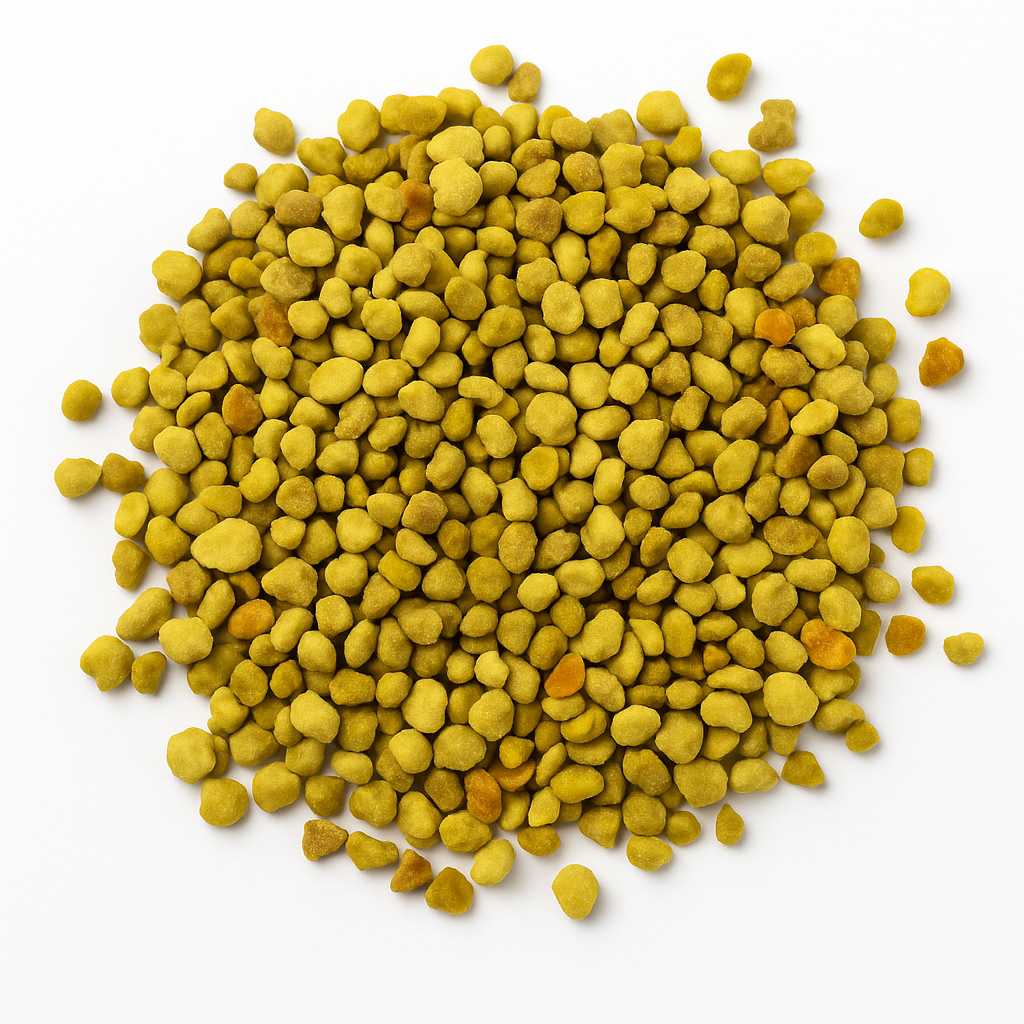Bee pollen is one of nature’s most powerful superfoods—and yet, most people know very little about it.
Collected by honeybees as they forage from flower to flower, bee pollen consists of tiny multi-colored grains—a mixture of pollen, nectar, and bee enzymes. These seed-like particles are usually yellow, black, or pale in color, and they sit right at the center of the flower, playing the role of male reproductive agents in plants.
Bees gather this pollen on their legs, roll it into small balls, and carry it back to their hives, where they deposit it into honeycombs. This becomes their primary source of protein and nutrition, crucial for sustaining the colony. And for humans? Bee pollen is packed with nutrients and health benefits you don’t want to miss.
🐝 How Is Bee Pollen Harvested?
Bee pollen is harvested using a pollen trap placed at the entrance of the beehive. When bees return from foraging, they squeeze through the trap, which gently knocks off some of the pollen from their legs.
This harvesting method is safe for bees and allows beekeepers to collect up to 5–10% of total pollen in a hive—rarely up to 20%. It’s a delicate and time-consuming process, but the result is pure, unprocessed bee pollen that retains all of its bioactive nutrients.
🧊 How Is Bee Pollen Stored?
Once collected, fresh bee pollen contains about 10–12% moisture. To prevent spoilage, it must be frozen or oven-dried.
Professional harvesters dry the pollen at 30°C in the dark, a method that keeps its nutritional value intact and avoids exposure to light or impurities. Once dried to about 4% moisture, the pollen forms crunchy yellow nuggets, which are then packed for use.
One strong bee colony can produce 5 to 15 kg of bee pollen per year, depending on the environment and foraging conditions.
🥄 Bee Pollen Dosage and Usage
Bee pollen is considered a natural dietary supplement. It contains over 200 biologically active substances your body needs to function well.
✅ Suggested dosage:
Start with a small amount (5–10 grams/day) to test tolerance. Gradually increase to 30–40 grams/day.
You can consume it:
-
Mixed with milk, honey, or yogurt
-
Sprinkled over salads or cereals
-
Blended into smoothies
Its taste is mildly sweet and floral, and its texture is crunchy—perfect for health-conscious individuals.
🍃 Nutritional Composition of Bee Pollen
The composition of bee pollen can vary based on flowers, climate, and geography, but on average it contains:
-
Carbohydrates: 30% (digestible, energy-rich)
-
Proteins: 23% (including 10% essential amino acids)
-
Natural Sugars: 26% (fructose and glucose)
-
Lipids: 5% (including essential fatty acids)
-
Phenolic Compounds: 2% (powerful antioxidants like flavonoids)
-
Vitamins: 0.07% (B1, B2, B6, C, A, D, E)
-
Minerals: 1.6% (iron, zinc, calcium, magnesium, potassium, phosphorus, etc.)
This makes bee pollen a nutrient-dense, all-natural supplement suitable for almost every age group.
💊 Medicinal Properties of Bee Pollen
Bee pollen is widely used in apitherapy—a form of alternative medicine that utilizes bee products for healing.
Its biological compounds make it:
-
Anti-inflammatory
-
Antimicrobial
-
Antifungal
-
Antiviral
-
A natural analgesic (pain reliever)
These properties work in two powerful ways:
-
Preventative: Protecting the body from diseases.
-
Therapeutic: Supporting recovery and healing.
🩺 Health Benefits of Bee Pollen
Here’s how bee pollen supports your overall health:
🫀 Prevents Blood Clotting & Heart Disease

Bee pollen keeps arteries clean and supports smooth blood flow, reducing the risk of heart attacks and blood clots.
🧠 Reduces Stroke Risk

Improved circulation means more oxygen reaches the brain and nervous system, helping prevent brain strokes and neurological disorders.
🛡️ Prevents and Supports Cancer Treatment

Chronic inflammation can lead to cancer. Bee pollen’s anti-inflammatory properties help stop this progression. It also helps boost recovery during or after cancer treatment.
🧹 Detoxifies Liver

Regular intake can detoxify liver tissues from harmful substances like chemicals, industrial waste, and pollutants—especially useful for people exposed to occupational hazards.
🧬 Boosts Immunity

Thanks to its immune-regulating properties, bee pollen strengthens your body’s defense system and promotes long-term wellness.
🏋️ Acts as a Diet Supplement
Bee pollen increases red blood cell count, improves appetite, and builds muscle strength—making it perfect for:
-
Athletes
-
Post-surgery patients
-
Children with poor appetite
-
Underweight individuals
😊 Fights Depression and Anxiety

When used alongside antidepressants, bee pollen has shown to reduce dosage needs and improve mood naturally—helping people rediscover their zest for life.
💡 Other Uses of Bee Pollen
Bee pollen isn’t just for direct consumption. It’s also used in:
-
Apitherapy (natural medicine)
-
Cosmetics and skincare (for anti-aging and healing)
-
Burn treatment ointments (for its regenerative properties)
🛒 Buying Bee Pollen: What You Should Know
Bee pollen is highly sensitive. Its nutrients can easily degrade if not handled or stored properly. So, always buy from a trusted or certified seller.
Look for:
-
Unprocessed, chemical-free pollen
-
Proper packaging and storage details
-
Local sourcing from genuine beekeepers
✅ Final Thoughts
Bee pollen is truly a superfood from the hive—packed with nutrients, antioxidants, and therapeutic properties. It supports your heart, liver, brain, and immune system, all while boosting your mood and energy.
So don’t wait. Add raw, high-quality bee pollen to your diet and experience the natural healing power that only the bees can deliver.
Stay fit. Stay healthy. Go Bee Pollen!

